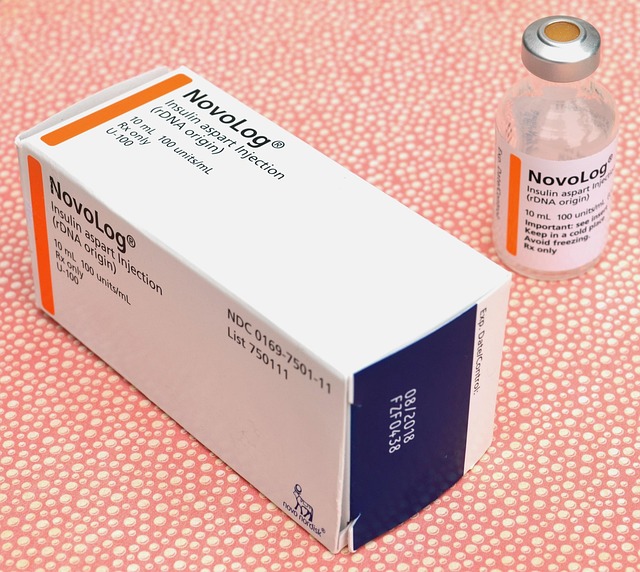Semaglutide Obesity Medication: A Comprehensive Solution
Semaglutide, a groundbreaking GLP-1 receptor agonist, revolutionizes obesity treatment by mimicking natural hormones to control blood sugar and appetite. Through increasing satiety and reducing hunger, it facilitates both weight loss and improved metabolic health. Clinical trials highlight its effectiveness, showing substantial weight loss and additional benefits like lower blood pressure. Semaglutide's personalized dosing schedule allows healthcare providers to tailor treatments to individual needs, enhancing outcomes and patient satisfaction. Side effects are manageable, emphasizing the importance of balanced diets and regular monitoring. As a versatile component in holistic treatment plans, semaglutide offers a promising path towards sustainable weight management, with advanced formulations and combination therapies on the horizon.
“Semaglutide emerges as a powerful tool in the fight against obesity, offering a personalized approach to treatment. This article delves into the science behind semaglutide, a glucagon-like peptide receptor agonist, and its transformative role in managing weight. We explore how this medication’s unique mechanisms lead to significant benefits, with a focus on tailored dosing for optimal results. By examining clinical studies, injection techniques, potential side effects, and its integration into comprehensive care plans, we uncover the promise of semaglutide as an effective semaglutide obesity medication.”
Understanding Semaglutide: A Glucagon-Like Peptide Receptor Agonist

Semaglutide is a groundbreaking obesity medication that has gained significant attention in recent years. It works by mimicking the effects of a natural hormone, glucagon-like peptide-1 (GLP-1), which plays a crucial role in regulating blood sugar levels and appetite. As a glucagon-like peptide receptor agonist, semaglutide stimulates these receptors, leading to increased feelings of fullness and reduced hunger. This action not only helps individuals eat less but also improves insulin secretion, making it particularly effective for managing type 2 diabetes alongside weight loss.
The medication is administered via injection, offering a more convenient and potentially more effective approach compared to some other obesity treatments. Its ability to suppress appetite has been well-documented, with clinical trials showing substantial weight loss in patients. Moreover, semaglutide’s impact extends beyond weight reduction; it can significantly lower blood pressure and improve cardiovascular risk factors, making it a game-changer in the management of obesity-related comorbidities.
The Role of Semaglutide in Obesity Treatment: Mechanisms and Benefits

Semaglutide, an innovative obesity medication, has emerged as a game-changer in the field of weight management. Its role in treating obesity goes beyond mere appetite suppression; it targets multiple physiological aspects to achieve sustainable weight loss. The medication mimics the action of natural hormones, increasing feelings of fullness and reducing hunger pangs. This mechanism not only helps individuals eat less but also alters their overall eating behavior, making them more attuned to satiety cues from their bodies.
The benefits of semaglutide extend beyond calorie reduction. It has been shown to improve metabolic health by enhancing insulin sensitivity, reducing blood pressure, and lowering bad cholesterol levels. These effects contribute to a lower risk of developing type 2 diabetes and cardiovascular diseases, which are often associated with obesity. Furthermore, semaglutide has demonstrated long-term efficacy and safety in clinical trials, making it a reliable option for personalized obesity treatment plans.
Personalized Medicine Approach: Tailoring Semaglutide Dosing for Optimal Results

In the pursuit of effective obesity treatment, a personalized medicine approach is gaining prominence. This strategy involves tailoring medical interventions to individual patient needs, recognizing that one-size-fits-all solutions often fall short. Semaglutide, a groundbreaking obesity medication, exemplifies this concept by offering a customizable dosing regimen. Healthcare providers can carefully adjust the dosage based on each patient’s unique metabolic profile and response to treatment.
This personalized touch is crucial in maximizing the benefits of semaglutide. By considering factors like body mass index (BMI), waist circumference, and existing health conditions, doctors can prescribe the optimal dose, enhancing weight loss outcomes and improving overall patient satisfaction. This tailored approach not only ensures better adherence to treatment but also promotes long-term sustainability, as patients experience personalized support and results aligned with their specific needs.
Clinical Studies Demonstrating the Efficacy of Semaglutide in Weight Management

Clinical studies have consistently shown that semaglutide, a novel glucose-dependent insulinotropic polypeptide (GIP) receptor agonist, is highly effective in managing obesity. These trials have demonstrated significant weight loss outcomes when semaglutide is administered as part of a comprehensive treatment plan. In one notable study, participants who received semaglutide injections experienced an average 8-10% reduction in body weight compared to those on placebo over a period of 56 weeks. The medication’s ability to curb appetite and stimulate satiety has been pivotal in these successes.
Furthermore, multiple randomized controlled trials (RCTs) have underscored semaglutide’s efficacy across diverse patient populations. These studies not only validate its role as a potent obesity medication but also highlight its potential benefits for related comorbidities. By targeting both weight loss and metabolic improvements, semaglutide offers a promising approach to managing obesity, providing patients with a more sustainable and healthier lifestyle.
Administering Semaglutide: Injection Techniques and Patient Comfort

Administering semaglutide, a cutting-edge semaglutide obesity medication, involves precise injection techniques to ensure optimal patient comfort and adherence to treatment. Healthcare providers typically inject semaglutide once weekly into the abdominal or upper arm area using a fine needle. This process is relatively simple and can be performed in a clinical setting or even at home with proper training.
To enhance patient comfort, many patients find that rotating injection sites helps reduce pain and discomfort over time. Additionally, using an injectable device designed for semaglutide administration can simplify the procedure, making it less intimidating for both patients and caregivers. The key lies in consistency and adherence to recommended dosing schedules, which not only supports weight management but also improves overall patient satisfaction with their obesity treatment plan.
Potential Side Effects and Management Strategies with Semaglutide Therapy

Semaglutide, while effective in treating obesity, is not without its potential side effects. Common adverse reactions include nausea, vomiting, diarrhea, and abdominal pain—side effects that often arise during the initial stages of treatment and can be managed with dietary adjustments and medication. Patients may also experience a range of metabolic changes, such as increased glucose levels, which require close monitoring by healthcare professionals.
To mitigate these effects, healthcare providers should emphasize balanced diets and regular physical activity. Regular check-ins allow for adjustments to the treatment plan based on individual responses, ensuring optimal management of both obesity and associated risks. Additionally, educating patients about potential side effects empowers them to actively participate in their care, reporting any concerning symptoms promptly.
Integrating Semaglutide into Comprehensive Obesity Care Plans

In recent years, semaglutide has emerged as a powerful tool in the fight against obesity, offering a novel approach to weight management. This medication, primarily known as a semaglutide obesity medication, is an innovative therapy that can be integrated into comprehensive obesity care plans. By mimicking natural hormones, semaglutide helps regulate appetite and promotes feelings of fullness, leading to reduced calorie intake and supporting weight loss efforts.
When incorporated into a tailored treatment plan, semaglutide becomes a versatile component. It can be combined with dietary interventions, exercise programs, behavioral therapy, and other medications to create a holistic strategy. Such an approach ensures that patients receive personalized care, addressing various aspects of obesity management. This comprehensive care is crucial in achieving long-term success, as it considers the physical, mental, and emotional dimensions of weight loss, making semaglutide a promising addition to modern obesity treatment regimens.
Future Perspectives: Research and Development for Advanced Semaglutide Formulations

As research continues to advance, the future of semaglutide in obesity treatment looks promising. Scientists are exploring innovative formulations and delivery methods to enhance its efficacy and patient convenience. One area of focus is developing long-acting semaglutide injections that could provide sustained weight management over extended periods. These advanced formulations aim to mimic the natural release of gut hormones, ensuring consistent suppression of appetite and food intake.
Additionally, researchers are investigating semaglutide’s potential in combination therapies, where it could be paired with other medications or lifestyle interventions for more comprehensive obesity management. The goal is to tailor treatments to individual patient needs, taking into account their specific health profiles and preferences. With ongoing clinical trials and advancements in pharmaceutical technology, the horizon for semaglutide obesity medication promises improved outcomes and a better quality of life for those struggling with this complex condition.
